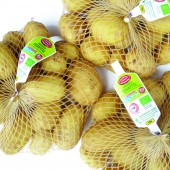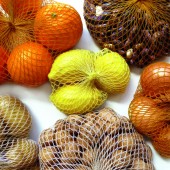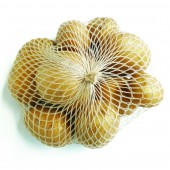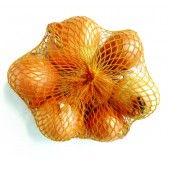
| THE AWARD |
| CATEGORIES |
| REGISTRATION |
| SUBMIT YOUR WORK |
| ENTRY INSTRUCTIONS |
| TERMS & CONDITIONS |
| PUBLICATIONS |
| DATES & FEES |
| METHODOLOGY |
| CONTACT |
| WINNERS |
| PRESS ROOM |
| GET INVOLVED |
| DESIGN PRIZE |
| DESIGN STORE |
| THE AWARD | JURY | CATEGORIES | REGISTRATION | PRESS | WINNERS | PUBLICATIONS | ENTRY INSTRUCTIONS |
Cellulose Net Tube Compostable Packaging by Verpackungszentrum Graz |
Home > Winners > Design #33244 >Interview |
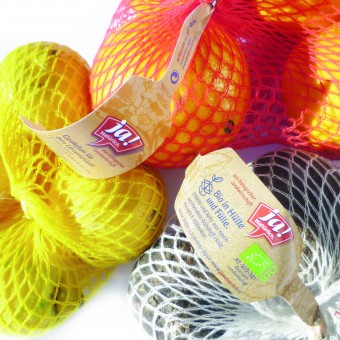 |
|
FS: What is the main principle, idea and inspiration behind your design?
VI: Evolution towards 100% green packaging
FS: What has been your main focus in designing this work? Especially what did you want to achieve?
VI: Netting has been 100% plastic almost everywhere until now. December 2013 marked the first ever appearance of biodegradable cellulose fibre netting sleeves on the shelves of retailer Rewe in Austria.
FS: What are your future plans for this award winning design?
VI: International marketing and extension of the product range and further R&D projects.
FS: How long did it take you to design this particular concept?
VI: 14 months
FS: Why did you design this particular concept? Was this design commissioned or did you decide to pursuit an inspiration?
VI: The global problem of waste packaging demands radical measures. The packaging market has been dominated by plastic for the past 40 years. A garbage slick called Great Pacific Garbage Patch the size of Central Europe was first discovered, drifting in the Pacific ocean, in 1997. Plastic packaging takes several hundred years to decompose. Since their invention, all plastic articles have been stacking up on our planet. Across the globe, only around 7% is recycled. Even though they may be out of sight, they break down into increasingly smaller pieces and mix in with the plankton in our seas, which has devastating consequences for the whole ecosystem. Synthetic materials cannot be extracted from the natural cycle of life. Compostable packaging decomposes within just a few weeks and is completely biodegradable.
FS: Is your design being produced or used by another company, or do you plan to sell or lease the production rights or do you intent to produce your work yourself?
VI: For the cellulose net tubes we are working in a partnership with the fibre producer Lenzing AG and the yarn producer Borckenstein GmbH. For international sales we will give production and sales licences.
FS: What made you design this particular type of work?
VI: Need of the market. Cooperation with REWE. Consumers are asking more and more for biodegradable packaging.
FS: Where there any other designs and/or designers that helped the influence the design of your work?
VI: Our partners Lenzing AG (fibre production), Borckenstein GmbH (yarn production), Henning (net production) and Erzeugerorganisation Marchfeldgemüse (packaging station) helped in the technical realization of the concept.
FS: Who is the target customer for his design?
VI: customers of organic food
FS: What sets this design apart from other similar or resembling concepts?
VI: It is a world first development and the youngest brainchild of the biogenic net packaging project of Verpackungszentrum Graz.
FS: How did you come up with the name for this design? What does it mean?
VI: The name contains the information about the raw material and the main property of the packaging.
FS: Which design tools did you use when you were working on this project?
VI: We are working with universities, engineers and designers. Natural packaging materials offer many new possibilities of colouring, styling or labelling.
FS: What is the most unique aspect of your design?
VI: Compostability
FS: Who did you collaborate with for this design? Did you work with people with technical / specialized skills?
VI: Engineers from Lenzing AG, Borckenstein AG, Netzfabrikation Henning and Erzeugerorganisation Marchfeldgemüse. For natural dyes we are working with the Institute for Textile Chemistry and Physics of the University Innsbruck.
FS: What is the role of technology in this particular design?
VI: There are new technology aspects on all production stages: the creation of the fibre (tensile strength), the new dying process of the fibre which only requires a small amount of dye, the creation of the yarn (twist) and the modification of machines in net production.
FS: Is your design influenced by data or analytical research in any way? What kind of research did you conduct for making this design?
VI: Test series with filling machines at the packaging station Erzeugerorganisation Marcheldgemüse and subsequent modification of the whole process. Certification of the compostability and the suitability for packaging of food. Sustainability Report.
FS: What are some of the challenges you faced during the design/realization of your concept?
VI: Overcome technical problems. Implementation of a new technology. Higher prices than synthetics.
FS: How did you decide to submit your design to an international design competition?
VI: It gives our product support in international marketing and spreads the idea very broad to the public and all stakeholders.
FS: What did you learn or how did you improve yourself during the designing of this work?
VI: We call our way "Evolution towards 100% green packaging". Step by step we want to offer new green concepts for packaging. Our success is the success of good partnerships with universities and engineers and the continuous development of a network of experts. We have our own Creative Workshop in the company and we are investing our money into research.
FS: Thank you for providing us with this opportunity to interview you.
A' Design Award and Competitions grants rights to press members and bloggers to use parts of this interview. This interview is provided as it is; DesignPRWire and A' Design Award and Competitions cannot be held responsible for the answers given by participating designers.
| SOCIAL |
| + Add to Likes / Favorites | Send to My Email | Comment | View Press-Release | Translations |
